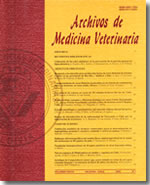Detection of bovine herpesvirus 1 and 5 in trigeminal ganglia of beef cattle in Uruguay
Main Article Content
Abstract
The present study aimed to detect BoHV-1 and BoHV-5 latent infections in Uruguayan beef cattle. Trigeminal ganglia (TG) were collected from 62 cattle heads in a slaughterhouse. Viral genomes were detected by a type-differential nested PCR (nPCR) targeting the UL44 gene of BoHV-1 and BoHV-5. Viral DNA was detected in 64.5% (40/62) of the animals. Thirty cattle heads (48.4%) contained only BoHV-1 DNA, whereas nine (14.5%) contained DNA of both BoHV-1 and BoHV-5. One cattle head (1.6%) contained BoHV-5 DNA only. Detection of neutralising antibodies was performed on sera of the examined cattle heads by a standard serum neutralization test. Neutralising antibodies were detected in 16 of the viral DNA-carrying animals, corresponding to 40% of the samples from which viral genomes were identified. The type-specific genomic prevalence was substantially different from that reported in a similar study carried out in Brazil and may be associated to the predominant European type of breeds farmed in Uruguay, as opposed to Brazilian cattle which is often crossbred (Bos Taurus x Bos indicus). Therefore, despite both BoHV-1 and BoHV-5 do circulate in Uruguay and sometimes both viruses can co-infect cattle, BoHV-5 infections seem less frequent than BoHV-1 infections.

